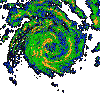Cyclones
A tropical cyclone is a type of low-pressure system which generally forms in the tropics. While some, particularly those that make landfall in populated areas, are regarded as highly destructive, tropical cyclones are an important part of the atmospheric circulation system, which moves heat from the equatorial region toward the higher latitudes.
A heat engine
Structurally, a tropical cyclone is a large, rotating area of clouds, wind, and thunderstorm activity. The primary energy source of a tropical cyclone is the release of heat of condensation from water vapor condensing at high altitudes. Because of this, a tropical cyclone can be thought of as a giant vertical heat engine.
The ingredients for a tropical cyclone include a pre-existing weather disturbance, warm tropical oceans (+-26° C surface temp), moisture, and relatively light winds aloft. If the right conditions persist long enough, they can combine to produce the violent winds, incredible waves, torrential rains, and floods associated with this phenomenon.
This use of condensation as a driving force is the primary difference setting tropical cyclones apart from other meteorological phenomena, such as mid-latitude cyclones, which draw energy mostly from pre-existing temperature gradients in the atmosphere. To drive its heat engine, a tropical cyclone must stay over warm water, which provides the atmospheric moisture needed. The evaporation of this moisture is driven by the high winds and reduced atmospheric pressure present in the storm, resulting in a sustaining cycle.
The terms "hurricane" and "typhoon" are regionally specific names for a strong "tropical cyclone" . A tropical cyclone is the generic term for a non-frontal synoptic scale low-pressure system over tropical or sub-tropical waters with organized convection (i.e. thunderstorm activity) and definite cyclonic surface wind circulation..
Tropical cyclones with maximum sustained surface winds of less than 17 m/s (34 kt, 39 mph) are called "tropical depressions". Once the tropical cyclone reaches winds of at least 17 m/s (34 kt, 39 mph) they are typically called a "tropical storm" and assigned a name. If winds reach 33 m/s (64 kt, 74 mph)), then they are called:
- "hurricane" (the North Atlantic Ocean, the Northeast Pacific Ocean east of the dateline, or the South Pacific Ocean east of 160E)
- "typhoon" (the Northwest Pacific Ocean west of the dateline)
- "severe tropical cyclone" (the Southwest Pacific Ocean west of 160E or Southeast Indian Ocean east of 90E)
- "severe cyclonic storm" (the North Indian Ocean)
- "tropical cyclone" (the Southwest Indian Ocean)
Sources : AOML and Armaegeddon online





